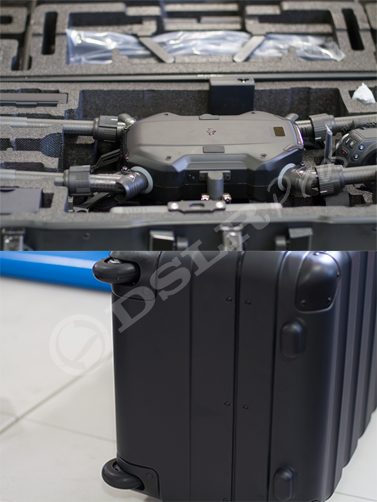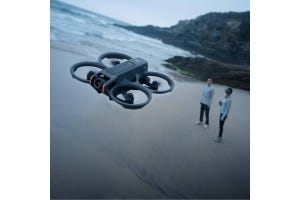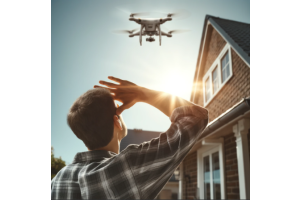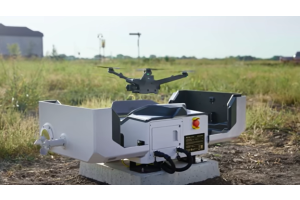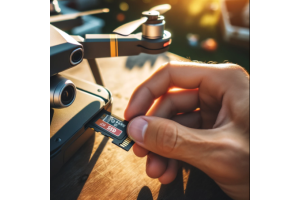The day has come! DSLRPros recently received our first Matrice 210 from DJI. The customer that particular unit was shipping to needed it quickly for damage assessment in the wake of Hurricane Harvey, so we wanted to make sure it was ready to go as soon as he received it. As with any brand new aircraft, there were a few kinks that needed to be sorted out.
Looking for some tutorials on how to swap out the gimbal mounts? We have you covered. Tutorial videos for the Matrice 210 are at the bottom of the page (look for our logo, they’re just below it).
The first impression of any product is the packaging and DJI definitely stepped up their game for the Matrice 210. It comes in a slightly beefier version of their old Inspire 1 case design, complete with a handle and wheel design, reinforced corners, and locking latches instead of their infamous zipper (which they included on the standard Matrice 200 case).
Once the case is opened, it is immediately familiar. The same style foam inserts DJI has been using for years. However, the awful velcro straps they have always used to secure propellers in the top portion of the case have been replaced with much more secure-feeling plastic latches (as seen in the top portion of the image).
Overall, the new(ish) style case for the 210 feels better than previous iterations of DJI’s OEM case. It is still no replacement for a GPC or Pelican case, but it will suffice for a while, and to put worries at ease: it fits the 210 with the dual gimbal mount on it as well without having to switch it out every time you store the aircraft.
Cendence / CrystalSky
The Matrice 210 Comes standard with a DJI Cendence remote controller outfitted with the 7.85″ CrystalSky monitor. It is definitely a step up from the standard DJI remote controller both in feel and usability. The extra customizable buttons give the controller a lot of flexibility for commercial operators to customize controls to fit their particular needs.
The CrystalSky monitor performed very well, with no visibility issues in bright afternoon conditions. Mounting the CrystalSky to the Cendence is quick and easy, and it feels very secure atop the controller. The cendence and CrystalSky also use the same external batteries, which are both supplied with the kit as well as a dual charger.
We were not able to activate the Matrice 210 with the CrystalSky monitor but had no issues with activation after plugging an iPad into the Cendence.
The general performance of the CrystalSky (ie navigating anything other than the DJI applications) is minimal. When going through the browser or main tablet settings, there is quite a bit of lag. Once the Go, Go4, or Pilot apps are up and running, the CrystalSky seems to perform its tasks at a steady pace. We had almost no transmission issues, freeze frames, or major lag while testing the aircraft. In comparison, Phantom 4 units generally give us at least a little lag in our area due to signal interference.
The Matrice 210
Out of the box, the Matrice 210 looks just like the Matrice 200 but with two rubber plugs on the top of the airframe (check the first image to see what we’re talking about). The drone feels solid, giving an air of confidence that the user will not have an issue in either performance or looking professional. Though the arms fold, they are very solid once secured in flight position. The quick release propellers also feel very secure, and huge in comparison to Matrice 100/Inspire 1 propellers.
Of course, the main attraction of the Matrice 210 over the Matrice 200 is the different gimbal configurations. Naturally, those were the first things we tackled. If you’re planning on using both setups for a job, make sure you plan for an extra hour of labor (it doesn’t quite take an hour, but you’ll inevitably have to search for a tiny screw that fell on the ground).
There’s no denying it’s pretty in either configuration, and the utility is practically endless! A plug-and-play gimbal mount swap system would have been nice, but for the time being a 30-minute swap will have to do.
Flight: Upwards Mounted Gimbal
Flight with the upward gimbal mount doesn’t change much from flying the single down. The only noticeable difference is how strange it feels to have the gimbal be in the wrong place and an extra GPS unit (included) sitting off to the side of that gimbal. Once you get past that strange feeling, the drone handles well.
Flight: Dual Downwards Mounted Gimbals
This is what we’ve been waiting for! The dual gimbal system was great once we got past the installation of the dual gimbal mounting system, and figured out how to get the “Pilot App” to work on the CrystalSky. We flew with two configurations: Zenmuse XT & Z30, Zenmuse XT & X4S. The 210 handles both configurations better than we anticipated. Keep in mind that the 210 is not a Phantom 4 Pro, there is no sport-mode so it’s not very fast. But it is stable.
The “DJI Pilot App” is extremely easy to use, and currently (as of 9/1/17) not available for anything other than the CrystalSky. We searched both Google Play and the Apple App Store to no avail, and the QR Code on DJI’s website will download an APK (Android Package Kit) that will not install on any Android devices that are even remotely close to up-to-date (we tried on multiple Android devices). As this app is a new addition to DJI’s app lineup, it is still a bit buggy. It is also not the easiest to find on the CrystalSky unless you know where to find it (we show you how below).
When flying with the Zenmuse XT and Z30 (our first dual gimbal flight) we got an error message saying there was an issue with the batteries. We were obviously concerned but figured out shortly after that this was an application error, not an actual battery problem. This issue will happen if the application is disconnected from the aircraft (to change batteries perhaps) and is not restarted itself. Once the application was closed and re-opened, the error message did not reappear with the same set of batteries. Shortly after that initial dual gimbal flight, we received a comment on our Instagram claiming there are “problems caused by flying 2 cameras without the right batteries.”
Despite not indicating which batteries may be the right or wrong batteries, we wanted to make sure there were no problems we may have missed. To be sure there were no issues, we completed several additional test flights with the “Matrice 200” labeled TB50s, as well as unlabeled TB50s (Inspire 2 batteries) with both the XT/Z30 setup and the XT/X4S setup with no error messages (we restarted the application between each power cycle for the aircraft).
OVERALL
When our few days of testing and learning about the Matrice 210 were up, we were a bit disappointed. We really didn’t want to have to send it out. Some things were a bit of a handful to figure out (like the pilot app issues) but in the end, we really enjoyed the Matrice 210, and look forward to the next one that has to be tested out.
The overall build quality is great, the customizability is perfect for people with varying job types, and of course, it’s a drone, so also fun to use.
TUTORIALS

